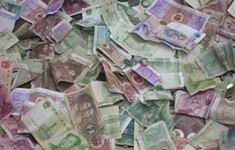 mminent internationalization of the Chinese currency could have a major impact on the country’s seafood trade, making exports more expensive but imports more affordable.
mminent internationalization of the Chinese currency could have a major impact on the country’s seafood trade, making exports more expensive but imports more affordable.Chinese policy makers are expected to announce the timetable for liberalization of currency controls and eventual convertibility of the Renminbi (RMB) in October when the Chinese communist Party leadership meets in Beijing to deliberate on much-mooted economic reforms needed to boost the country’s flagging economic growth.
Worries over further appreciation of the Renminbi, seen as a likely outcome of internationalization, were expressed by ten seafood exporters in Qingdao and Dalian contacted by SeafoodSource. Analysts watching the country’s listed seafood companies meanwhile have noted that the RMB has been steadily appreciating in value over the past five years, making Chinese seafood exports more expensive but imports more affordable as the RMB rises in value.
China’s currency is currently non-convertible, meaning approvals are required in order to bring significant sums into or out of the country. Chinese companies are currently paid in dollars, which are then converted by central authorities on entry to the country. China has been wary of currency liberalization, fearing an outflow of funds by Chinese businesses seeking better opportunities overseas.
However China’s government has stated its aim to make the RMB a more dominant global currency — requiring it to fully open its capital account — it will in turn allow Chinese seafood exporters and importers to trade more easily given they’ll be able to trade the Renminbi freely across China’s borders.
Business advisors in Beijing see currency liberalization as a mixed bag for Chinese seafood firms preparing for an eventual full convertibility. “The basic effect of a fully convertible currency will be a reduction of import costs and an increase in export costs,” said Russell Brown, head of China-based accounting and advisory firm Lehman Brown.
“It’s more difficult to decipher the effect in China’s case because many of their export goods have a percentage of imported goods,” Brown told SeafoodSource.
The dismantling of currency controls could also lead to a surge of Chinese investment into seafood businesses overseas, as well as easier processes for would-be investors to get money into China. “A lot of Chinese companies are looking to invest overseas but because of currency exchange controls, small firms especially are not able to invest because they can’t get RMB out easily,” said David Chu, principal at the leading China-based ShineWing Hall Chadwick Certified Public Accountants. He told SeafoodSource that international investors are likewise keen to enter the Chinese market but are put off by the bureaucratic process of converting currency.
Experts in Beijing argue that China has to first liberalize its bank interest rate mechanism — currently set by central government rather than the market — before making its currency convertible. Otherwise Chinese banks would be unable to compete efficiently for funds. A steady, controlled appreciation of the RMB (also known as the Yuan) in recent years in the past decade — excluding a period between 2008 and 2010 when the currency was effectively frozen has seen China’s currency appreciate an average 7 percent a year in value against the U.S. dollar. The RMB had long been pegged to the U.S. dollar at CNY 2.46 per USD 1.00 until China, seeking to boost its exports, in the late 1970s switched tack and devalued the Yuan so that by 1994 the currency was trading at RMB 8.62 to the dollar.
China’s export-oriented industries, including seafood processors, benefitted from artificially low costs, but pressure from China’s trading partners, principally the U.S., forced China’s hand. Since 2005, the CNY exchange rate has been allowed to float in a narrow margin around a fixed base rate determined by China's central bank around a basket of world currencies. While China re-pegged its currency to the dollar in 2008 (until 2010) in the midst of the financial crisis, China has recently again allowed the RMB to float, within tightly controlled boundaries. As of 8 July a dollar was worth RMB 6.13 and had slipped to RMB 6.01 by the end of the month, suggesting continued strengthening of the RMB.





